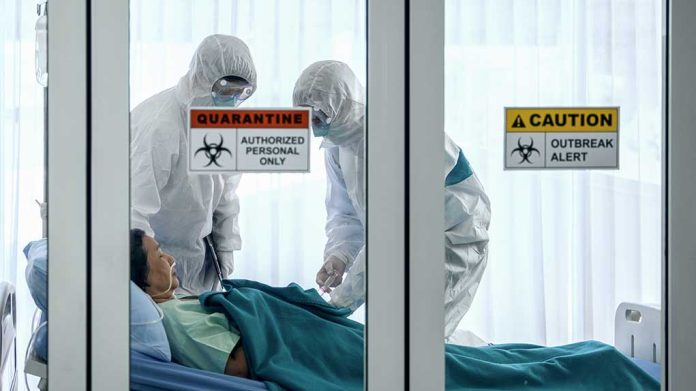
A deadly, drug-resistant fungus that kills up to 60% of its victims is spreading rapidly through American hospitals, posing an imminent threat to vulnerable patients while frustrating healthcare workers struggling to contain the contagion.
Key Takeaways
- Candida auris cases have more than doubled annually since 2016, reaching 4,514 cases in 2023, with California reporting the highest number at 1,566 infections.
- The fungus has been classified as an “urgent threat” by the CDC due to its 30-60% mortality rate, resistance to antifungal drugs, and ability to persist on surfaces despite normal cleaning procedures.
- High-risk patients include those with catheters, breathing tubes, feeding tubes, or compromised immune systems, particularly in hospitals and long-term care facilities.
- Standard hospital disinfectants are often ineffective against C. auris, requiring specialized EPA-registered products and rigorous infection control protocols.
- Recent surges in Georgia and Florida healthcare facilities highlight the fungus’s aggressive spread and the urgent need for improved surveillance, diagnostics, and infection prevention measures.
A Deadly Invader in American Healthcare
Candida auris, a highly lethal fungal pathogen first identified in the United States in 2016, has become a growing nightmare for American healthcare facilities. Cases have exploded from just a handful seven years ago to over 4,500 confirmed infections in 2023, with the most severe outbreaks concentrated in California, New York, Illinois, Florida, and Georgia. The rapid proliferation of this stubborn fungus presents a formidable challenge to hospital infection control teams already stretched thin by years of pandemic response and healthcare staffing shortages.
“The rapid rise and geographic spread of cases is concerning and emphasizes the need for continued surveillance, expanded lab capacity, quicker diagnostic tests, and adherence to proven infection prevention and control,” said Dr. Meghan Lyman, a medical officer at the CDC’s Mycotic Diseases Branch, highlighting the urgency of the situation.
Why C. auris Threatens American Patients
What makes Candida auris particularly dangerous is its triple threat of resistance, persistence, and lethality. The fungus has demonstrated resistance to multiple classes of antifungal drugs, severely limiting treatment options for infected patients. Perhaps more alarming is its ability to survive on surfaces for weeks or even months, easily transferring between patients through contaminated medical equipment or healthcare workers’ hands. Most conventional hospital-grade disinfectants, especially those using quaternary ammonia compounds, prove ineffective against this resilient pathogen.
The mortality statistics alone should raise serious concerns about public health preparedness. Patients infected with Candida auris face a grim prognosis, with death rates estimated between 30-60%. While many victims already suffer from underlying conditions, the fungal infection often delivers the final, fatal blow that overwhelms compromised immune systems. Most commonly, C. auris targets patients with invasive medical devices like breathing tubes, feeding tubes, and catheters, creating a particular danger in intensive care units.
Infection Control Challenges
Hospital administrators and infection prevention specialists face significant hurdles in containing C. auris outbreaks. Unlike bacteria that respond to standard sterilization protocols, this fungal threat requires specialized EPA-registered disinfectants specifically tested against C. auris (List P) or Clostridioides difficile spores (List K). Many facilities lack immediate access to these products or struggle with implementation across busy healthcare environments. The situation highlights years of neglect in America’s public health infrastructure and infection control readiness.
“Most of the patients that get infections with Candida auris are themselves pretty sick to start with. This is something that can push people over the edge and become life-threatening,” explained Stuart Cohen, chief of the Division of Infectious Diseases at UC Davis Health.
Patient Protection Measures
For Americans concerned about potential exposure, several protective steps are recommended when entering healthcare settings. Patients should ask their doctor about facility infection rates and prevention protocols before elective procedures. During hospital stays, insist that all healthcare workers properly sanitize hands before patient contact and wear appropriate protective equipment, especially when coming from another patient’s room. Those with loved ones in long-term care facilities should request information about any recent outbreaks and the facility’s response measures.
“The goal is, first and foremost, to keep the people in your hospital safe. When somebody comes in for a procedure, they’re not expecting to go home with a life-threatening illness or having spent time in an ICU from a hospital infection,” Cohen emphasized, underscoring the ethical responsibility of healthcare providers to protect vulnerable patients.
Government Response and Future Concerns
The CDC has issued increasingly urgent warnings about C. auris, classifying it as an “urgent antimicrobial resistance threat” in its 2023 reports. However, critics argue that federal response has been inadequate compared to the severity of the threat. Limited funding for hospital infection control programs, shortages of trained infection prevention specialists, and insufficient regulatory oversight have all contributed to the fungus gaining a foothold in American healthcare facilities. Without more aggressive intervention and funding for antimicrobial resistance efforts, experts warn C. auris could become endemic in American healthcare settings.
As facilities struggle to contain this emerging pathogen, Americans should remain vigilant about infection control practices during any healthcare encounter. With continued spread and evolution of resistance patterns, Candida auris represents one of the most significant infectious disease threats facing the nation’s vulnerable patient populations and healthcare system today.






















